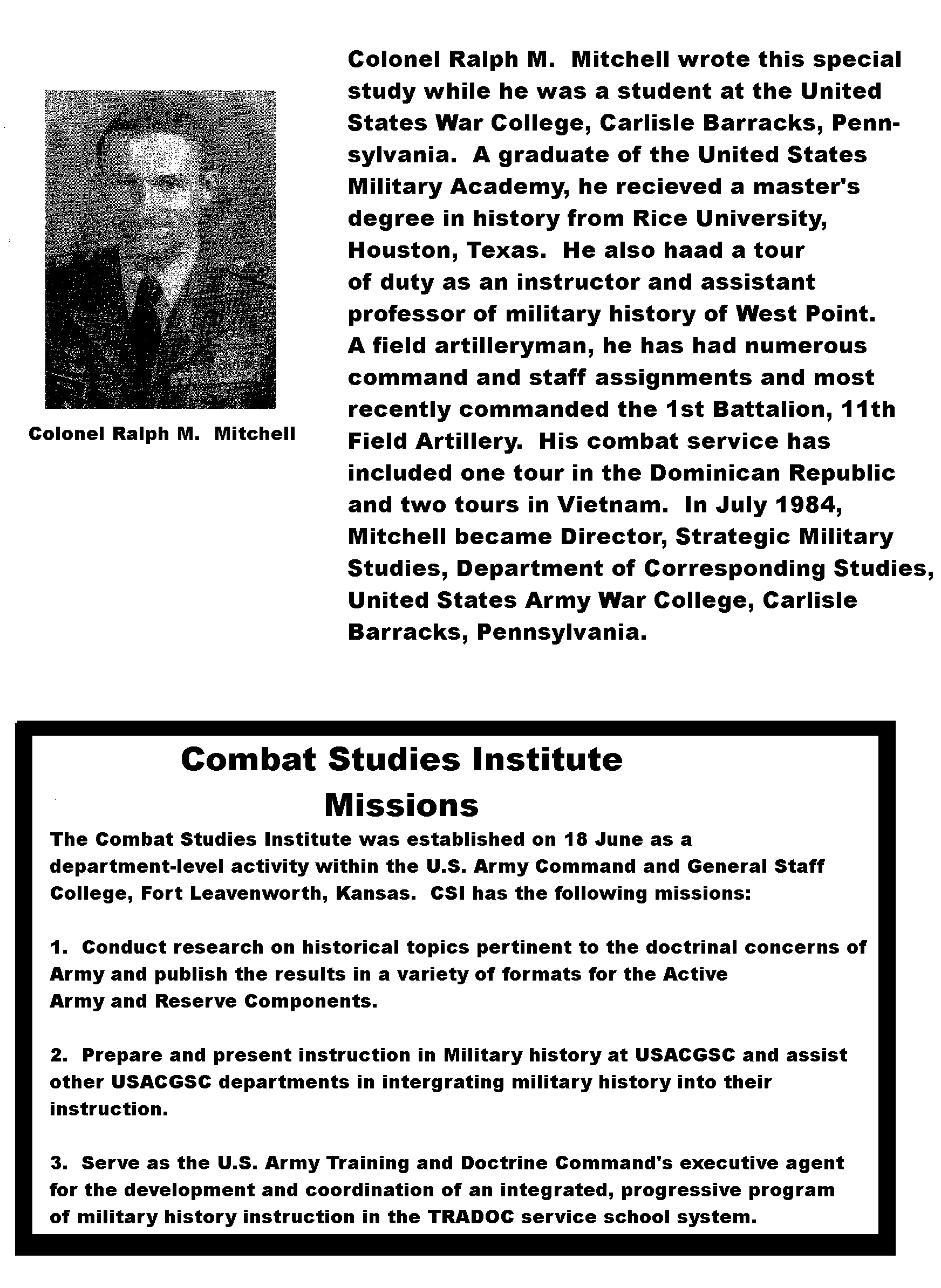|
The 101st Airborne Division's
Defense of Bastogne
by: Colonel Ralph M. Mitchell
September 1986
FOREWORD
The defense of Bastogne during the Battle of the Bulge
in World War II is one of the supreme achievements of American arms. Bastogne
is deservedly identified with the finest characteristics of the American
soldier, and the name Bastogne symbolizes a heroic battle. Bastogne has long
held the attention of students of war, yet the battle offers new insights
for soldiers with modern concerns.
Colonel Ralph M. Mitchell's study, The 101st Airborne Division's Defense of Bastogne,
reveals how a light infantry division, complemented by key attachments, stopped
an armor-heavy German corps. Using original documents and reports, Colonel
Mitchell traces the fight at Bastogne with emphasis on the organization,
movement and, employment of the 101st Airborne Division. Although a variety
of factors influenced the outcome at Bastogne, the flexibility of the 101st
to reconfigure for sustained operations and to defeat strong opposition forces
even when surrounded shows how properly augmented light infantry can fight
and win.
LOUIS D. F. FRASCH
Colonel, Infantry
Director, Combat Studies Institute
CSI publications cover a variety of military history topics. The views
expressed herein are those, of the author and not necessarily those of the
Department of the Army or the Department of Defense.
Library of Congress Cataloging-in-Publication Data
Mitchell, Ralph M. (Ralph Molyneux), 1942-
The 101st Airborne Division's defense of Bastogne.
"September 1986."
Bibliography: p.
1. Ardennes, Battle of the, 1944-1945. 2. United
States Army. Airborne Division, 101st--History
3. World War, 1939-1945--Regimental histories--United
States. I. Title.
D756.5.A7M58 1987 940.54'21 86-28316 |
CONTENTS
|
1. Troop dispositions before the German advance |
2 |
|
2. The road and rail configuration, Bastogne area |
3 |
3. The German plan for the Ardennes offensive,
December 1944 |
4 |
|
4. Situation, 19 December 1944 |
18-19 |
|
5. Situation, 20 December 1944 |
20-21 |
|
6. Situation, 21 December 1944 |
22-23 |
|
7. Situation, 22 December 1944 |
24-25 |
|
8. Situation, 23 December 1944 |
26-27 |
|
9. Situation, 24 December 1944 |
28-29 |
|
10. Situation, 25 December 1944 |
30-31 |
|
11. Situation, 26 December 1944 |
32-33 |
By October 1944, the rapid Allied advance into Germany that followed the breakout from the Normandy beaches had
slowed to a crawl. Stiffening German resistance and Allied logistical and communications problems exerted a significant
influence on the Allied advance. In the American sector, Lt. Gen. Omar Bradley's 12th Army Group occupied an extended
front, with the First and Third Armies along the Siegfried Line and the Ninth Army facing the Roer River. There would be
little change in these positions in October and November1 (see map 1).
The First Army had an extensive line of defense near Aachen, Germany.
Maj. Gen. Troy H. Middleton's VIII Corps occupied that army's southern sector.
Its 88-mile front extended from Losheim, Germany, north through eastern Belgium
and Luxembourg to where the Our River crosses the Franco-German border. The
corps' mission was to defend in place in a relatively quiet sector. There,
new divisions could receive a safe indoctrination, and battle-weary ones
could rest and reconstitute for future operations. Headquarters, VIII Corps,
was located in the small Belgian town of Bastogne. The area around Bastogne
was characterized by rugged hills, high plateaus, deep-cut valleys, and restricted
road nets. Bastogne itself was the hub for seven roads and a railroad.2 Both sides understood the significance of that fact (see map 2).
Alarmed by the continuing grave situation in the east,
Adolph Hitler saw an opportunity for a decisive offensive in
the west as the Allied offensive stalled there. Without complete
support from his closest advisers, he directed the launching of
a winter offensive against the western Allies through the Aisne-Ardennes sector of the front. The purpose was to recapture the
important port of Antwerp while encircling and destroying the
21st Army Group. In so doing, Hitler would turn the fate of the
war in Germany's favor.3 Middleton's VIII Corps, however, was
directly astride the main avenue of advance of the Fifth Parizer Army.
TO VIEW: Map 1: Troop dispositions before the German advance
Few German officers were privy to the plans for this offensive,
called Watch on Rhine. Most Germans thought preparations were for defensive measures until a few days before the
attack began.4 Operating with little insight as to the ultimate
objectives of their own units, many commanders had insufficient
opportunity for reconnaissance and failed to consider the numerous
contingencies that might soon arise. They remained
unaware of the tactical implications of their situations, while
Hitler's intuition was allowed to prevail.5
TO VIEW: Map 2
The Germans, however, had identified Bastogne as a possible
point of major difficulty and had considered the control of the
vital crossroads through that town to be absolutely necessary
to maintain their rear area lines of communication. Hitler had
expressly ordered Bastogne's capture, and that mission had been
passed through Army Group (Heeresgruppe) and Fifth Army to
XLVII Panzer Corps, which would be attacking through the
Bastogne sector. Specifically, the corps was to cross the Our
River on a wide front, bypass the Clerf sector, take Bastogne,
and move to and cross the Meuse River south of Namur6 (see
map 3). The corps' commander, General Baron Heinrich von
Luettwitz, had specifically asked about Bastogne at a conference
in Kyllburg prior to the offensive. In the presence of General
von Manteuffel, the Fifth Army commander, von Luettwitz was
told that Bastogne would definitely have to be taken. Accordingly,
in instructions to his subordinates, he stated: "Bastogne
must be captured, if necessary from the rear. Otherwise it will
be an abscess in the route of advance and tie up too many
forces. Bastogne is to be mopped up first, then the bulk of the
corps continues its advance."7
TO VIEW: Map 3
In light of such specific guidance prior to the operation, it
is curious that the Fifth Panzer Army staff did not interpret
those instructions the same way. Chief of Staff, Brig. Gen. Carl
Wagener, stated, "Bastogne would not necessarily have to be
taken but merely encircled. This would avoid any loss of time
east of the Maas [Meuse]." The Germans expected that the
advance to the Meuse would not be delayed by any attack on
Bastogne because both would be accomplished simultaneously.8
Luettwitz also differed with Fifth Panzer Army about the
amount of time it would take his men to reach the Meuse. The
Fifth Panzer's staff expected the attack to take four days; the
commander of XLVII Panzer Corps thought it would take six
days and had doubts about taking Bastogne by the end of the
second day as Fifth Army had projected.9 Luettwitz had good
reason to be pessimistic.
In the midst of general confusion about the forthcoming
operation, pessimism seemed the order of the day, and vital
planning went awry. Luettwitz himself doubted whether the
offensive would succeed. The Germans had to achieve surprise,
and the Allied air forces somehow had to be neutralized. Hitler
would have to deliver both a sufficient quantity of fuel and the
3,000 German aircraft he had promised on 11 December 1944.
Perhaps the attacking German columns could reach the Meuse,
but without divisions to cover their extended flanks and without
adequate bridging equipment, there was little hope that they
could push farther.10
With the attack scheduled for 16 December 1944, there was
good reason for German concern. The number of their soldiers
available had steadily decreased, most units had not been rested,
and all units encountered significant shortages of organic weapons,
tanks, trucks, spare parts, ammunition, and fuel. Moreover, there were no plans to capture enemy supplies, and the
success of the operation did not hinge on that possibility.
German general staffs at all echelons also believed that the
enemy had no strategic reserves available on the Continent and
that there would be little Allied resistance in the Bastogne
area.11 Both assumptions proved fatally incorrect.
The XLVII Panzer Corps consisted of the 2d Panzer Division,
Panzer Lehr Division, and the 26th Volksgrenadier Division, all reinforced by one volks mortar brigade, one volks
artillery corps, and the 600th Army Engineer Battalion for
bridging purposes. None was at full strength. The 2d Panzer
Division had been in the rear area for four weeks to rest and
refit. It had only 80 percent of its authorized personnel and
equipment, but its commanders were seasoned veterans. One
panzergrenadier battalion was on bicycles to save fuel and
vehicles. It would be totally unfit for combat in the hilly roads
of the rugged Ardennes and ultimately would have to be used
only for replacement troops.
The Panzer Lehr Division had just returned from the Saar
area. It had 60 percent of its troops, 40 percent of its tanks
and tank destroyers, 60 percent of its guns, and 40 percent of
its other types of weapons. One tank battalion had no tanks
and, thus, was unavailable for the attack. In its place, the
division received the 539th Heavy Tank Destroyer Battalion
equipped with 30 percent of its authorized Panther tank destroyers.
Due to previous battle losses, the 26th Volksgrenadier
Division was without one regiment. But the remainder of the
division was at full strength and had several seasoned senior
commanders. Many subordinate commanders, however, were
without previous combat experience, and the division had not
been trained in offensive operations. Organizations later assigned
to the XLVII Panzer Corps in operations around Bastogne would
arrive in poor condition, with strengths ranging from 50 to 70
percent. These included the 9th and 116th Panzer Divisions, the
3d and 15th Panzergrenadier Divisions, and the F¸hrer Begleit
(Escort) Brigade.12
Following a heavy artillery bombardment at 0500 on 16
December 1944, the Germans launched their offensive, gaining
surprise and immediate local successes in all sectors. In the
American VIII Corps sector alone, twenty-five German divisions
were attacking. They struck and advanced through the veteran,
but weary, 28th and 4th Infantry Divisions as well as the green
106th Infantry Division and the equally inexperienced 14th
Cavalry Group. Only in the 4th Division sector was action light.
The only U.S. corps reserve consisted of an armored combat
command and four battalions of combat engineers.13
Amid much confusion and disorganization in the American units,
the Germans advanced steadily, but not as rapidly as they had hoped.
Poor roads became overcrowded, and small pockets of determined
resistance waged by American infantry and armored
units slowed, but did not stop, the German advance. The Allied
high command realized that Bastogne was threatened and reserves
were needed immediately. Accordingly, on 17 December
1944, the 101st Airborne Division, then in Camp Mourmelon,
France, resting and refitting after operations in Holland, was
alerted to move to the vicinity of Bastogne. Bastogne, if held,
could interrupt lines of communication as the Germans continued
their attack westward. But, meanwhile, VIII Corps'
defenses were crumbling, and the Germans, who averaged four
to eight miles advance on the first day, were within eleven miles
of Bastogne. Time had become a critical factor.14
The race was on!
The 101st Airborne Division, the unit chosen to stem the
advance, was a well-trained, veteran outfit. Prior to and during
its deployment in Europe, the unit had placed special training
emphasis on decentralizing and massing artillery, the repair and
operation of enemy equipment, air-ground liaison, signal security,
night operations, and defense against mechanized, aerial, and
infantry infiltration.15 Its strength at the time of the alert was
805 officers and 11,035 enlisted men. Included in its organization
were four infantry regiments and all supporting arms, though
there were shortages of personnel and equipment. Its commander,
Maj. Gen. Maxwell D. Taylor, was in the United States.
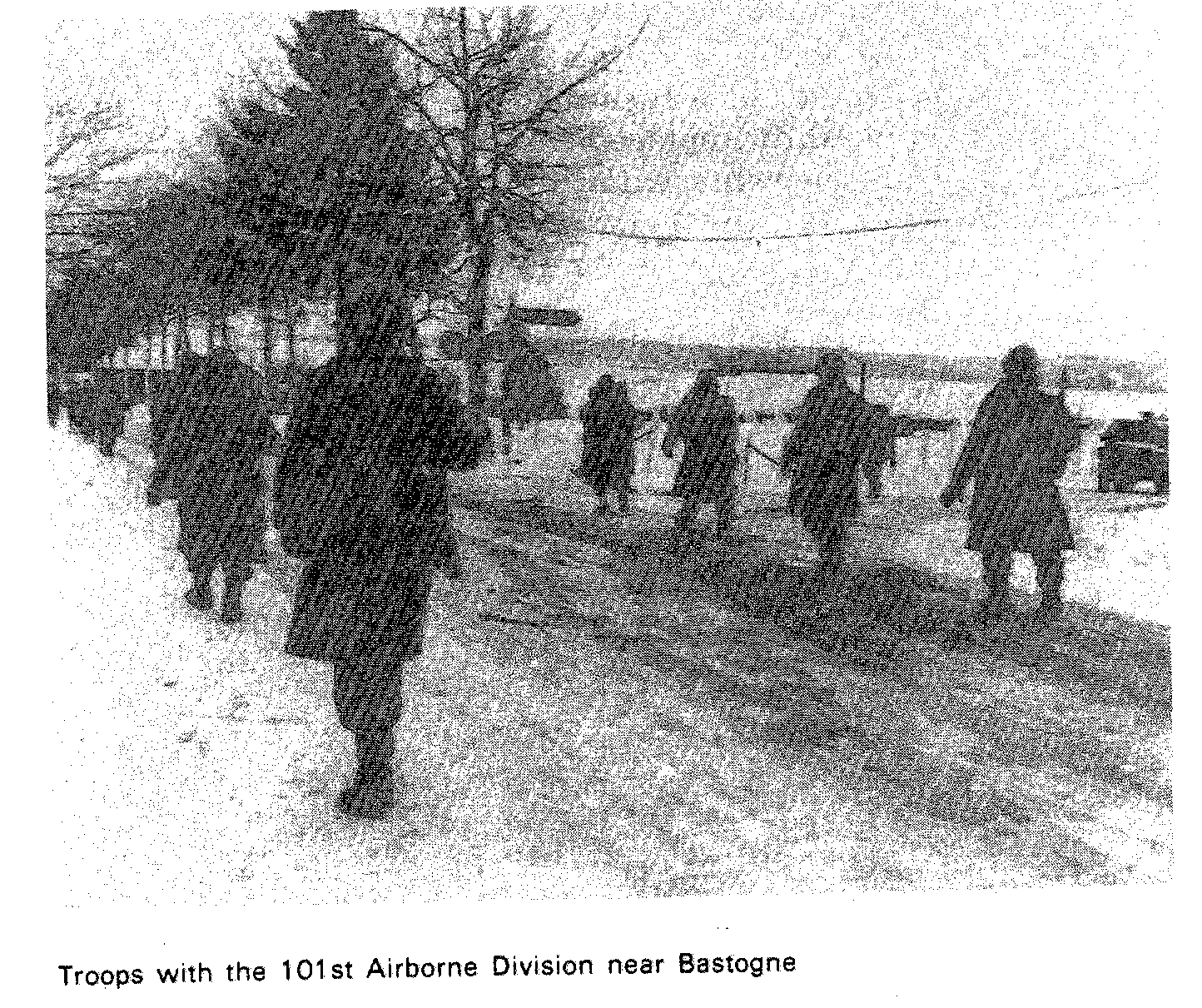 His deputy, Brig. Gen. Gerald J. Higgins, was in England with
five senior and sixteen junior officers. Command of the division
for operations around Bastogne, therefore, fell to Brig. Gen.
Anthony C. McAuliffe, the division's artillery commmander.16
In record time, he got the division on the road moving toward
the town of Werbomont, twenty-five miles north of Bastogne,
where he was originally ordered to report. In an oversight that
could have led to catastrophe, however, no one had informed
the division that it was now attached to VIII Corps. The advance
party that reached Werbomont on the night of 18 December only
then discovered they were meant to report to Bastogne.
His deputy, Brig. Gen. Gerald J. Higgins, was in England with
five senior and sixteen junior officers. Command of the division
for operations around Bastogne, therefore, fell to Brig. Gen.
Anthony C. McAuliffe, the division's artillery commmander.16
In record time, he got the division on the road moving toward
the town of Werbomont, twenty-five miles north of Bastogne,
where he was originally ordered to report. In an oversight that
could have led to catastrophe, however, no one had informed
the division that it was now attached to VIII Corps. The advance
party that reached Werbomont on the night of 18 December only
then discovered they were meant to report to Bastogne.
General McAuliffe's fortuitous stop in Bastogne to confer
with Middleton in late afternoon that day saved the rest of the
division the same fate. Learning of his attachment to VIII Corps
and receiving orders from Middleton to defend Bastogne,
McAuliffe made immediate preparations to reroute and receive
the division. This was accomplished superbly by a few staff
officers without the help of any advance party. As McAuliffe's
columns moved through heavy traffic toward Bastogne, forty
tanks from Combat Command B (CCB), the 10th Armored Division,
the 705th Tank Destroyer Battalion (with 76-mm self-propelled guns),
and two battalions of 155-mm artillery were ordered to Bastogne to
be attached to the 101st. These organizations and a makeshift
replacement pool of stragglers-Team Snafu-from U.S. elements
withdrawing near Bastogne, would bolster the defense of the
101st Airborne Division throughout the critical period in the
battle for Bastogne.17

Even as the 101st and its attachments were moving into
Bastogne during the night of 18 December, the German advance
had moved rapidly down the Wiltz-Bastogne road to a point
just three kilometers from the town. There they collided with
the first elements of the 101st. With VIII Corps evacuating the
area, the defense of Bastogne became the division's task.18
The paratroopers had barely won the race for the town; now the
problem was to hold it.
In the early stages of the German advance, supply difficulties had
not been a particularly critical issue. While, some German division commanders
had hoped to capture American supplies, none relied on that possibility for
a primary source of resupply. Fuel, however, was immediately in short supply
because only half the promised initial issue was delivered. Furthermore,
unusually heavy consumption rates, brought about by rough terrain and poor
weather near Bastogne, further drained the meager fuel supplies. Throughout
the operation, the fuel situation would only worsen for the Germans.19 But until
18 December, the XLVII Corps heading for Bastogne was still in
good fighting shape: there was good cooperation throughout the
corps; reports were timely; communications were good; troop
morale was reasonably high; the attack had begun on time on
the 16th; and the U.S. 28th Infantry Division's first line of
defense had been broken.
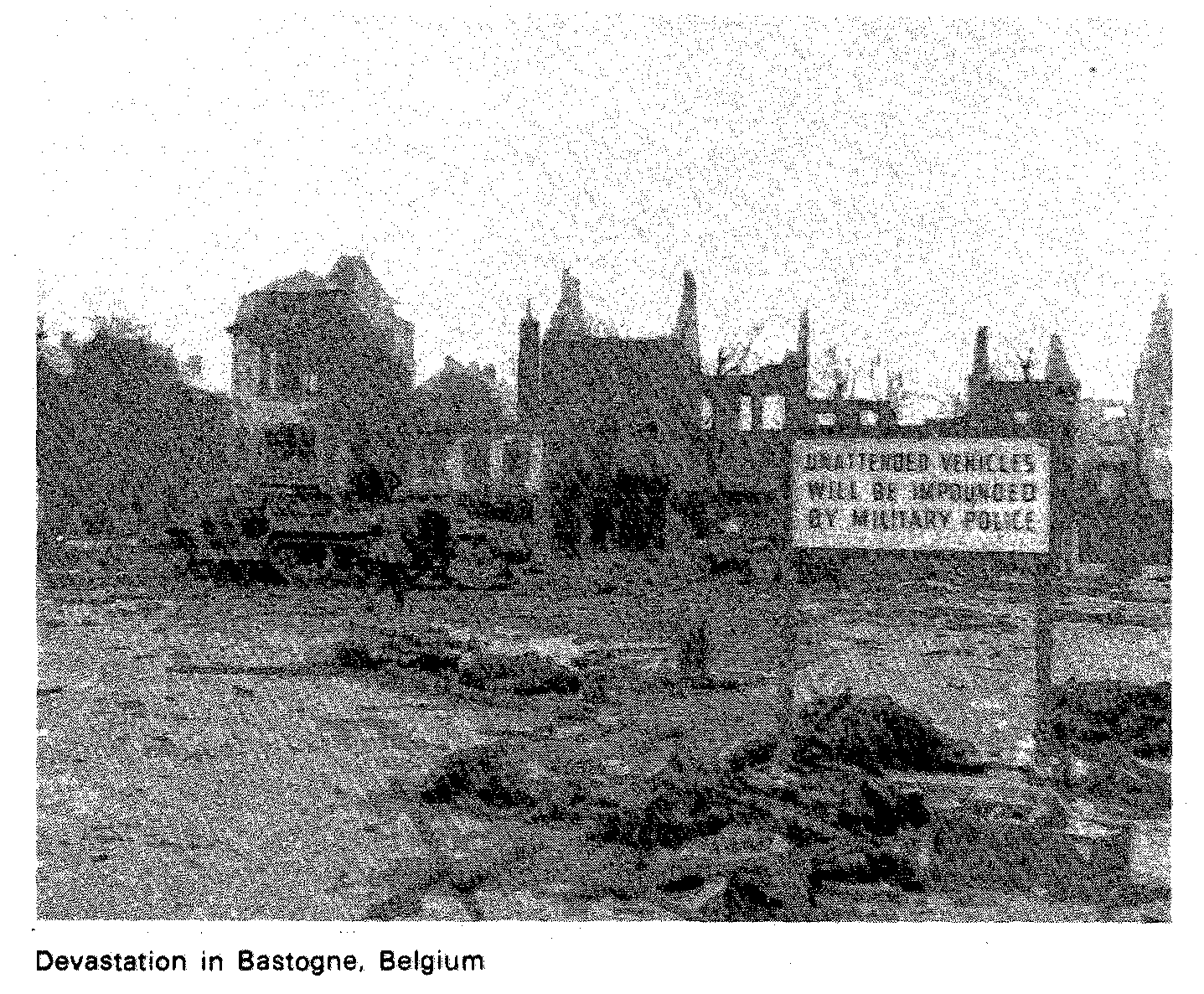
Even so, there had been some serious problems that threw
the XLVII Corps off its timetable. Unanticipated high water
across the Our River caused delays while engineers extended
and bolstered bridges for tanks to cross. Elimination of abatis
(constructed by both Americans and Germans while on the defensive)
and the filling in of craters caused additional delays.
Because of poor roads and few bridges, two assault divisions
were involved in a bottleneck at one vital bridge. These hindrances,
combined with a stiffening American resistance that
was in greater depth than the Germans expected, prevented the
Panzer Lehr Division from arriving in Bastogne at the appointed
time-1800, 18 December 1944. Had the Germans arrived on
schedule, the 101st would have been five kilometers west of the
town. After the Germans intercepted an alert message by the
101st on 17 December and discovered the paratroopers' projected
18 December arrival time in Bastogne, greater pressure was
placed on the XLVII Corps for a more rapid advance. However,
there was no advice on how the corps should overcome the
obstacles it faced nor was there any offer of assistance.20
As the 101st and its attachments, practically on the run,
formed a perimeter in the villages around Bastogne on the night
of 18 December, the tide of events had begun to turn. German
troops, pressed by their commanders for a faster rate of advance,
were near exhaustion. Previous losses of men and equipment
and the prospects for more of the same sapped their will to
fight.21 The American units they now faced were
fresh, motivated, and in control of Bastogne. But Bastogne
would be hotly contested in the week ahead.
By any comparison, the Americans, with a light infantry
(paratroop) division, some additional artillery, forty tanks, and
a tank destroyer battalion, should not have been a match for
the superior German forces, which consisted of two panzer divisions
and a volksgrenadier division; yet they were. Their ability
to resist the Germans at Bastogne was enhanced by their timely
occupation of the town. Low German morale also strengthened
U.S. resolve. The Germans of Army Group West and the Fifth
Panzer Army had no choice but to sustain the momentum of
the offensive at all costs in accordance with Hitler's demands.
Ultimately, German commanders who were too far removed from
the action would make fateful decisions that would allow the
lightly equipped defenders of Bastogne to survive.
The first steps to save Bastogne were taken on 18 December,
when Middleton dispatched the recently arrived Combat
Command B to the northeast, east, and southeast of the town with
orders to hold their positions at all cost.22 Such action indicated
to the Germans that Bastogne would not be surrendered. In the
week that followed, the Germans squeezed the perimeter around
Bastogne tighter and tighter, but it did not break.
Throughout the defensive sector, McAuliffe organized the
101st and its attachments into regimental task forces. Each had
its proportional share of artillery, tanks, antitank, and antiair
forces. Thus, light infantry received supplemental firepower in
their defense. With the exception of artillery, the Germans were
similarly organized. Their artillery was kept primarily in general
support.
On 19 December (see map 4*), small German infantry-armor
forces, both with and without artillery support, infiltrated under
cover of bad weather. German action also included night
fighting with tanks. The Americans resisted strongly in all
sectors, defending outlying villages and road intersections. By
nightfall, XLVII Corps had been contained along the line
Noville-Bizory-Neffe. The inadequate road network; old,
brokendown and overloaded German vehicles; and the American artillery around Bastogne were slowing the German advance. With
pressure from Heeresgruppe to push beyond Bastogne, Fifth
Panzer Army and XLVII Corps decided that the Panzer Lehr
Division should take Bastogne on the twentieth while the other
forces continued their westward advance.23
On 20 and 21 December (see maps 5 and 6), the same
pattern of small-unit infiltration continued, with some gains
accruing to the Germans. The villages of Noville and Bizory
were finally taken, but an attack against Marvie was repulsed.
Bastogne continued to be a matter of concern to XLVII Corps.
But it was believed on the twentieth that, with advances continuing
north and south of the town, Bastogne would soon be
encircled and that the 26th Volksgrenadier Division following
the panzer divisions could capture it. Indeed, the town was
surrounded on the twenty-first, but the 26th Volksgrenadier
Division was not strong enough to take it. Though surrounded, the
101st was not cut off. The division still maintained communication
with VIII Corps and knew an American relief column was
pushing toward them as German advances along the entire
Western Front were diminishing. The Fifth Panzer Army refused
to authorize sufficient additional forces to take Bastogne and to
keep the faltering offensive alive. But the 26th Volksgrenadier
Division still had the mission, with some help from the Panzer
Lehr Division. On the evening of 21 December, Manteuffel and
Luettwitz composed the now famous surrender note that, after
being delivered to the 101st on 22 December, received McAuliffe's
more famous reply: "Nuts."24
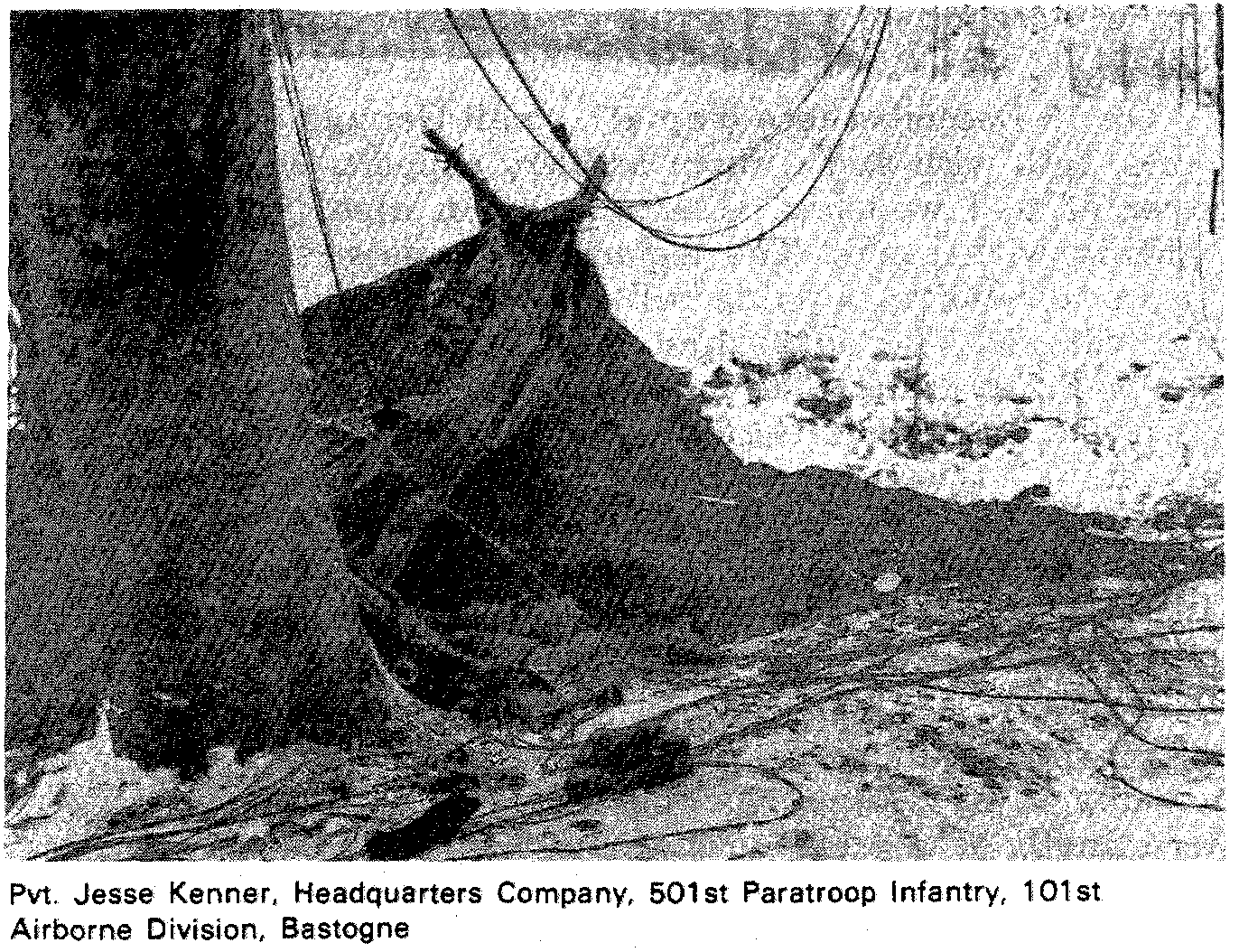
In addition to the note on 22 December, there were continuous
probes along the entire perimeter (see map 7). Only two
German attacks of any significance occurred, however, and both
were no larger than company size. On 23 December (see map
8), probes continued to the west and southeast, but the weather
had cleared and American airpower was beginning to take its
toll of German forces and equipment. Aerial resupply also began
that day, bringing the 101st badly needed supplies and sending
American morale soaring.
The Germans were becoming desperate. The XLVII Corps
was informed that the 9th Panzer Division and 15th Panzergrenadier
Division would come under corps control on 24 December,
and the 3d Panzergrenadier Division would arrive
later. Heeresgruppe still insisted on Bastogne being taken in
conjunction with the advance to the Meuse, but with Fifth
Panzer Army now on the defensive almost everywhere and the
possibility of advancing to the Meuse River becoming slimmer
each day, Army Chief of Staff General Wagener felt "the initiative
seemed to have passed to the enemy."25
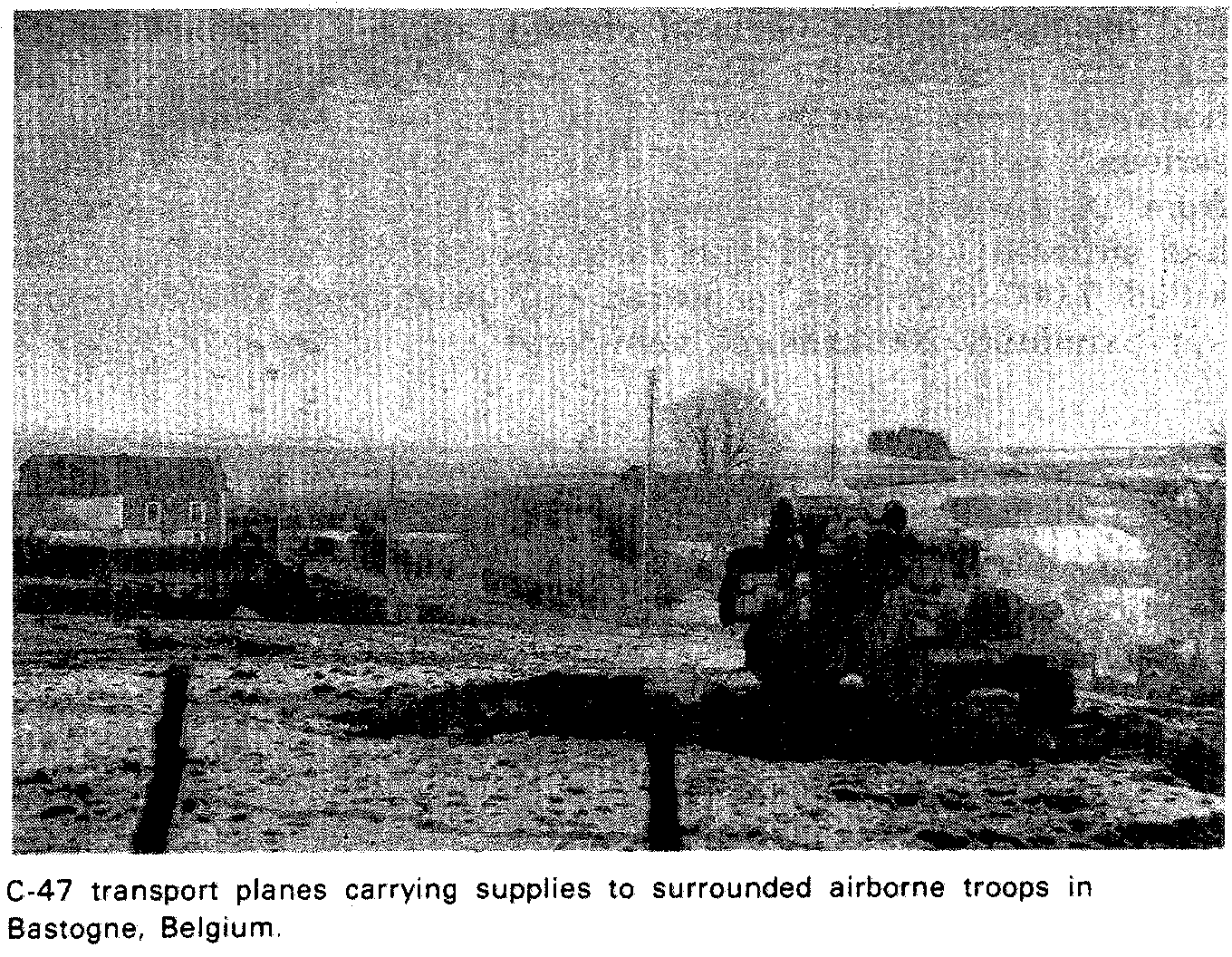
The situation on 24 and 25 December (see maps 9 and 10)
revived Luettwitz' hope that his corps could take Bastogne.
Reinforcements now promised by Fifth Panzer Army were essential
for this success. During the night of 24 December, German
combined arms and infantry attacks by pessimistic
commanders and uninspired soldiers were uncoordinated and
failed. On the twenty-fifth, the ring around Bastogne was
tightened as a result of regimental-size attacks, but again, they
were uncoordinated. The American advantage of interior lines
clearly served to complicate German attempts to coordinate their
efforts. That evening, XLVII Corps, apprehensive about the
American relief column pushing through, requested reinforcements and wanted to call off the attacks. The German Fifth
Army, appreciating the situation but powerless to act, could only
offer sympathy and a promise to look for more reinforcements.26
On 26 December (see map 11), German forces again attacked
with battalion-size infantry and armor teams. Striking American
combined arms teams arrayed in depth, the Germans were again
unsuccessful. Other units, forming for attack in assembly areas,
were attacked by American artillery and dispersed. At 1600 that
afternoon, American tanks broke through the 2d Panzer and
26th Volksgrenadier Divisions and linked up with the 101st. All
hope for German success had died. The XLVII Corps had no
forces available to eliminate this penetration, and the Fifth
Panzer Army's offer of the F¸hrer Begleit Brigade was too little
and too late.27 Light German probing attacks continued on the
27th and 28th, but the XLVII Panzer Corps' defensive inclinations
were more predominant. The 101st had held Bastogne and
seriously retarded the German Ardennes offensive.28
In action from 18 through 27 December, the 101st and its attachments
had suffered 115 officer and 1,933 enlisted casualties. They had
killed 7,000 Germans, captured 697 prisoners, and destroyed
approximately 200 armored vehicles.29
TO VIEW: Map 4. Situation, 19 December 1944
TO VIEW: Map 5. Situation, 20 December 1944
TO VIEW: Map 6. Situation, 21 December 1944
TO VIEW: Map 7. Situation, 22 December 1944
TO VIEW: Map 8. Situation. 23 December 1944
TO VIEW: Map 9. Situation, 24 December 1944
TO VIEW: Map 10. Situation, 25 December 1944
TO VIEW: Map 11. Situation, 26 December 1944
Though fighting in the villages around Bastogne pitted a
multidivision force against a reinforced light division, combat
for the most part was characterized by small-unit actions. Fate,
as it always does, played a significant role in the outcome, but
a more detailed look at how the 101st was organized and
equipped to fight also provides insight into its success. Firepower
for the light division was far greater than would have
ordinarily been the case. In addition to its own artillery of four
battalions, the division had at its disposal a field artillery group
consisting of two 155-mm gun battalions and a 4.5-inch howitzer
battalion. It also had one 155-mm gun and two 105-mm howitzer
battalions (which had fallen back after initial German assaults
on 16 December). In all, that meant that as many as ten field
artillery battalions could have supported the division at any one
time. Two battalions of the attached group were overrun and
lost on 20 December after the group commander moved them
without permission. For his actions, he was summarily relieved
that day by General McAuliffe.30 But even with that loss, the
American artillery in Bastogne was still a potent force, especially
when compared to the weaker German artillery.
When alerted for movement to the Bastogne area, the 101st
Division's artillery was still reconstituting from operations in
Holland. Many of the howitzers were in poor condition but were
repaired or replaced before the road march. Anticipating a
departure from their traditional airborne role, the artillerymen
reconfigured for land movement and consequently carried with
them far more ammunition than they would, or could, otherwise
have taken via aircraft.31 Without the additional loads, they
would have run out of ammunition before aerial resupply was
possible.
Upon arrival at Bastogne, all battalions task organized for
a static defense. Personnel shortages, especially in forward
observer and liaison teams to supported infantry, quickly became
acute. Headquarters and firing units were stripped to fill the
void. Command, control, and communications problems, as well
as general supply shortages, occasionally detracted from the
effectiveness of the defense but were never insurmountable. The
biggest problem remained a shortage of ammunition. As the
intensity of the fighting increased and overland supply lines
were cut, ammunition conservation became critical.32
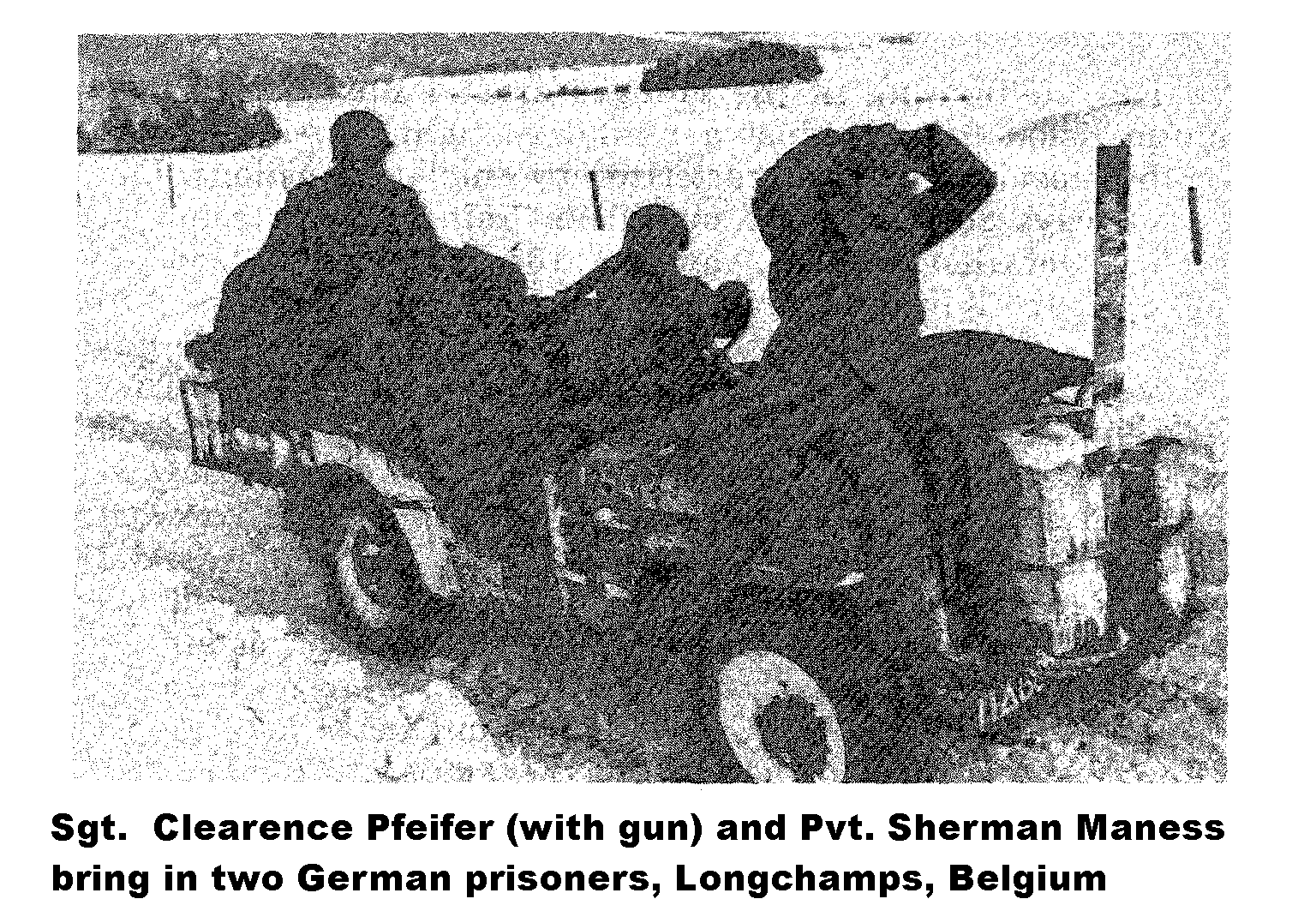
The majority of all rounds fired were directed against enemy
armor. Firing in the direct and indirect mode, artillery was
effective against German tanks, while unsupported infantry
rarely stopped the German armor. But had it not been for the
timely aerial resupply of 23 December and subsequent drops on
succeeding days, the guns would have fallen silent and been
easy prey for attacking German forces. By that day, some units
were down to less than three high-explosive rounds per howitzer
and had no remaining rations.33
As it was, the Germans had much to be concerned with
when in the vicinity of American artillery. The cold, hungry,
and exhausted artillerymen manning the guns repeatedly stated
their willingness to endure any deprivation if only they could
get some more ammunition. American morale was excellent, and
no German tank within range of American artillery was safe.
The encirclement and the widely disseminated 22 December
surrender note were considered amusing incidents rather than aweinspiring threats. On Christmas Eve, an entry in one battalion
journal read, "Christmas Eve, and all personnel here wish for
plenty of ammunition and one good supply route." On Christmas
day, the entry read, "Three cooks in C Battery took a little
time from their regular chores to kill two Germans in a tank
with a grenade, and captured six others."34 That same day,
another artillery battalion, under attack by seven tanks and
accompanying infantry, employed its howitzers as antitank guns
and destroyed two tanks, captured one intact, killed a number
of infantrymen, and captured twenty-four others. Similar actions
occurred throughout the operation. On 20 December alone, no
less than seven battalions fired 2,600 rounds solely at enemy
armor.35 The incomprehensible German failure to attempt to
destroy or neutralize American artillery only served to bolster
the cannoneers' confidence and determination. In his after-action
report, one direct-support battalion commander wrote, "After
arriving at Bastogne and going into position, we found ourselves
in exactly the situation we had been trained to handle."36
Perhaps that was ultimately why they acquitted themselves so
well.
A prime example of task organizing can be seen in the case
of the division's 81st Airborne Antiaircraft Battalion. Entering
combat with three antiaircraft and three 57-mm antitank batteries,
that unit found its role quickly changed to meet the
German armor threat. Initially, the antiaircraft batteries supported
the division's artillery, but they were shifted to the main
line of resistance (MLR) to strengthen the defensive perimeter.
While that action caused division headquarters and the division
artillery to be more vulnerable to German air strikes, it provided
firepower where it was most needed-in ground support in the
secondary line of defense.
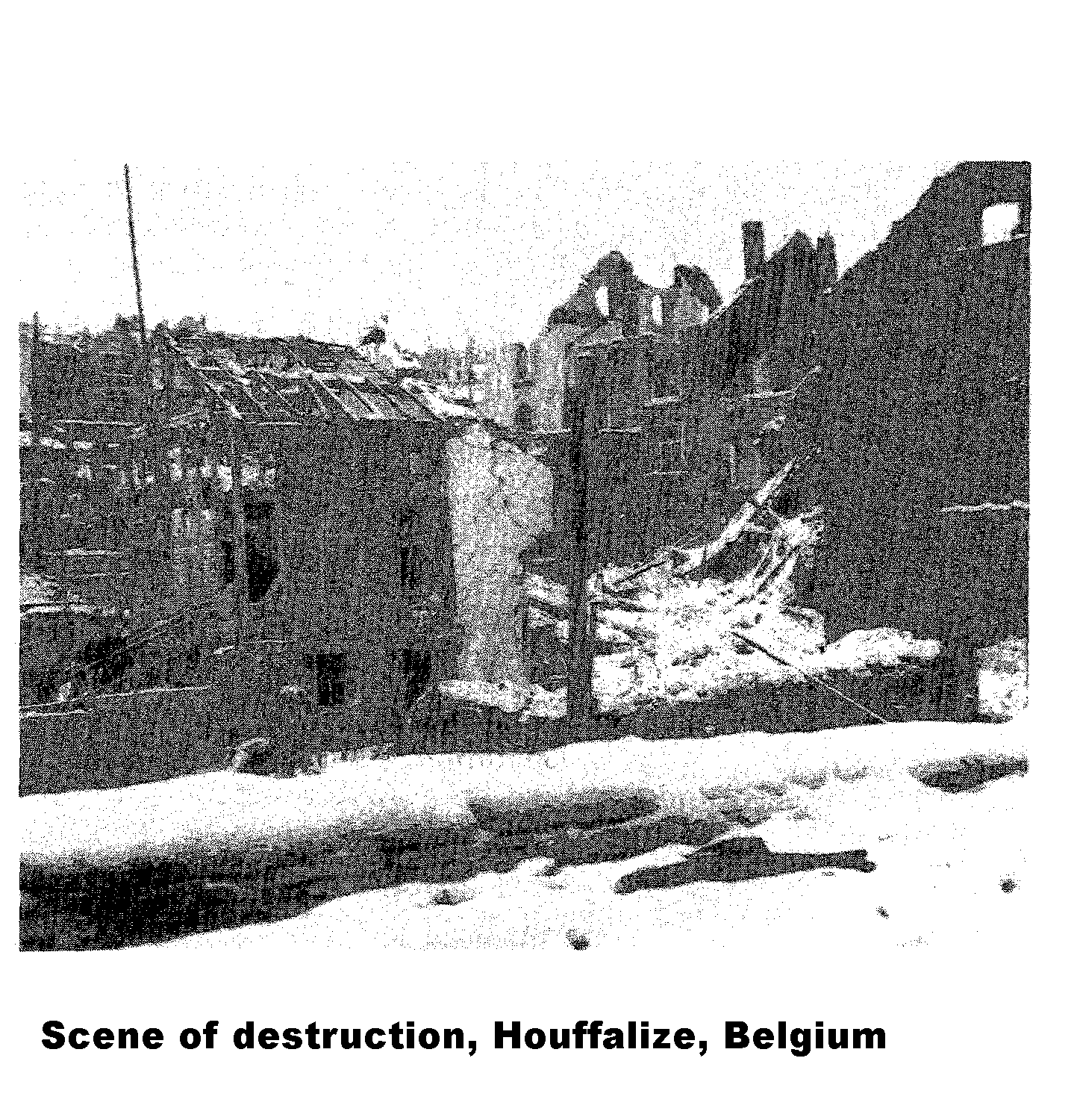
The antitank batteries were also positioned on the MLR,
where, in conjunction with the larger vehicles of the tank
destroyer battalion, they formed a defense in depth that the
Germans could not penetrate without unacceptable losses. The
81st's weapons would engage German tanks at maximum range,
slow the German tanks, and thus give the more mobile tank
and tank destroyer units time to move to the point of the
German attack and defeat the enemy's armor. Time and again,
this technique was used to counter uncoordinated enemy thrusts
that came from all directions.37
Other effective antitank measures included active infantry
patrolling to give early warning of German assembly or attack,
preparation of tank barriers and obstacles, and aggressive
hand-to-hand fighting to separate German infantry and tanks
after penetrations had occurred. Most tanks were destroyed after
they had penetrated the defenses and had been separated from
their infantry. That task was most frequently accomplished by
direct-fire artillery, antitank weapons, and bazooka fire at close
range.
Typical of the close-in violence of the battles was an incident on
23 December in the town of Marvie. There, Pfc. Norman
Osterberg, a member of the 327th Glider Infantry Regiment,
exposed himself to intense enemy fire and, using his bazooka,
repeatedly drove attacking tanks away even though they came
within ten yards of his position. Wounded in the process, he
continued his stand for three hours, thus stopping the attack in
his sector. Such bravery and esprit were common throughout
the elite division. Fighting against tanks, soldiers quickly discovered
that digging in around a town was far preferable and
more effective than occupying its buildings and being crushed
in the rubble.38 Teamwork, cooperation, effective combined arms
attacks on targets, and stubborn and brave resistance gave the
paratroopers a fighting edge they never relinquished.
The successful defensive activities at Bastogne were made
possible in good measure through the efforts of the 101st Signal
Company, which provided outstanding communications support
and ensured excellent command and control. From the beginning,
the signal company was hard pressed to keep communications operational in an encircled town subject to intense enemy
fire. Their task began when the division was first alerted. Signal
loads had to be configured for ground, rather than airborne,
operations. Their deployment was excellent, and by 0600, 19
December, all elements were in radio and wire contact with
division headquarters. Secure and nonsecure communications with
VIII Corps were also established and never lost throughout the
operation. Indeed, these were the only links with the outside
after Bastogne was surrounded.
Batteries for radios posed a problem. With only a three-day
supply, the division had to rely on strict supply economy and
conservation. Even with such conservation measures, many
divisional units ran out of essential batteries on the 23d; but
that was the day they were resupplied by air. Wire was also
constantly being broken by shelling, bombing, and heavy equipment
passing over it. Teams serviced the lines constantly, often
under fire. From the first day, signal personnel continuously
expanded the net, establishing alternate routes, laterals, and
additional circuits.
Communication among units was rarely lost. Radios were
in poor condition from the Holland operation, but they were
sufficient to meet all divisional requirements. The nets established
allowed for real-time dissemination of intelligence information from all sources, even down to local patrols. Frequent
German jamming was overcome, as was the problem of friendly
elements nearby operating on division frequencies. Contact was
established with the 4th Armored Division two days before that
element broke through to the 101st, and it was maintained
continuously from that point until no longer needed. Wire communication
was established as soon as the linkup occurred.39
With such signal efficiency, it is no wonder that the Americans
enjoyed communications superiority.
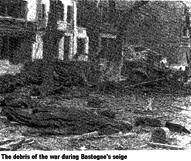
Flexibility and adaptability also characterized the 101st's
operations in and around Bastogne. The most serious problem
occurred during the night of 19 December, when the Division
Clearing Station, operated by the 326th Medical Company, was
overrun by six German vehicles (half-tracks and tanks) supported
by 100 infantrymen. In that action, the Germans captured
18 American officers and 124 enlisted men, as well as most of
the unit's medical equipment and supplies. Until a surgical team
arrived by glider on 26 December, only two medical and two
dental officers, four medical administration officers, and 113
enlisted men remained to handle all of the division's medical
needs. A makeshift casualty collection station had to suffice
because there were no means to evacuate the wounded after 20
December. The station quickly became overcrowded. Medical
supply shortages soon plagued the operation, and the overworked
staffs primary focus became the survival of the wounded
by any means available. Over 1,000 American and German
wounded eventually were treated at the collection center.40
Another major problem for the division was the constant
shortage of supply and maintenance troops. The 801st Ordnance
Company started for Bastogne on 19 December. Five miles from
the town, the Germans ambushed them. The Allied command
then diverted the unit and placed it under VIII Corps' control
until 29 December.41 Therefore, the division had
no direct support maintenance or evacuation capability until after
the Allies broke the German encirclement.
More serious was the supply situation. Convoying supplies
to Bastogne on 19 December, the 426th Quartermaster Company
was ambushed and subsequently diverted to VIII Corps' control
until 27 December.42 The division was, in effect,
without normal supply operations during the entire period. Further
complicating matters was the loss of the division's reconnaissance
platoon on 22 December. The platoon had been used to establish an
antitank warning net and had called for and directed field artillery
fire to destroy German tanks. But on leading a cut-off artillery battalion
to safety at Neufchteau, the platoon was isolated
and would not return until 28 December.43
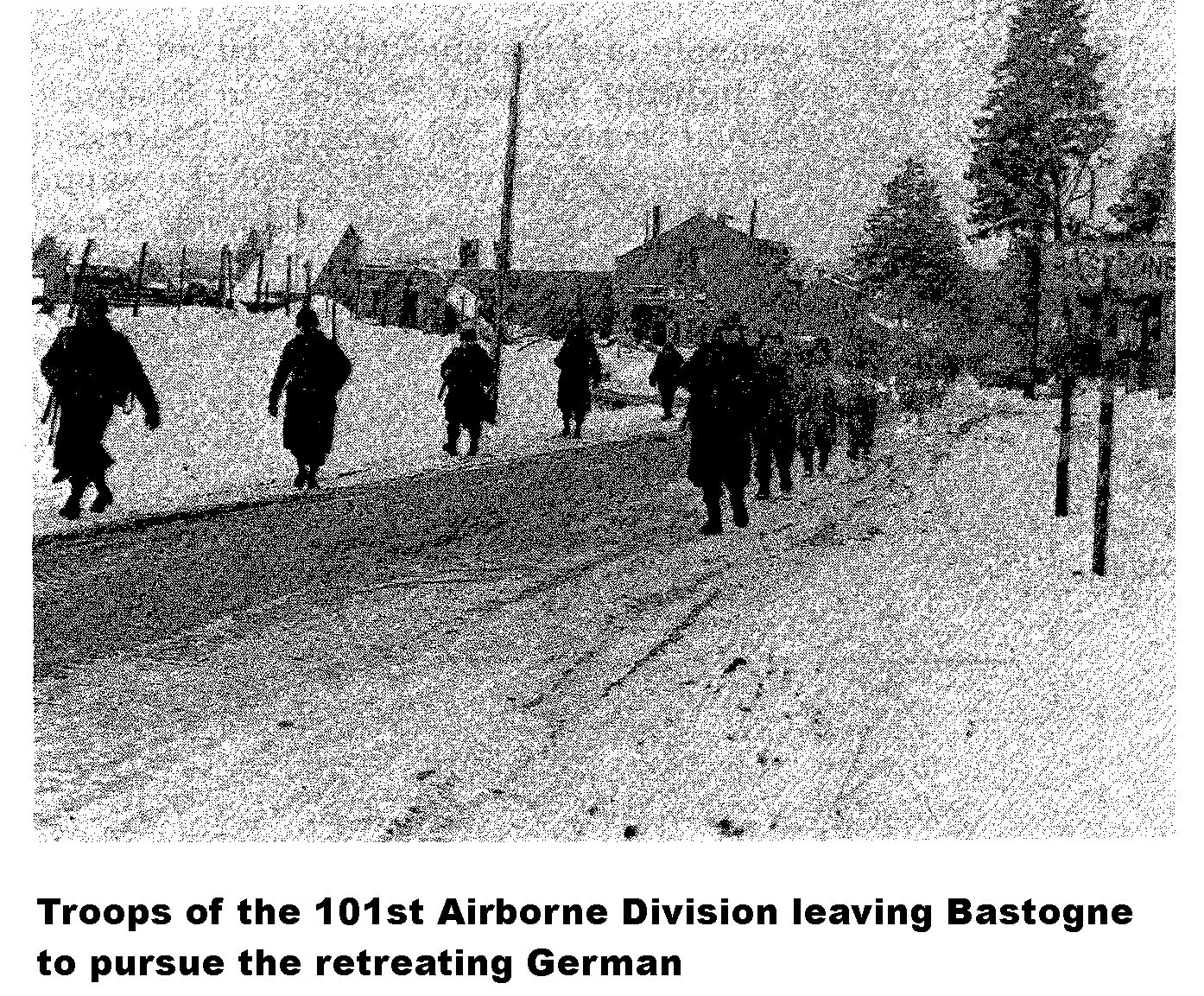
According to its commander, the 326th Engineer Battalion
might as well have been among the missing. Its deployment
around Bastogne was a classic case of misuse through ignorance.
Although the men set up a few roadblocks and prepared
several bridges for demolition, they were committed piecemeal
as infantry early in the battle rather than in their engineer support
role with the different regiments. When promised infantry
protection to accomplish engineer tasks, the engineers
frequently found themselves alone, unprotected, and exposed.
Fighting as infantry, they had no responsive, designated artillery
support.44 Strangely, no one used them in any way to prepare
antitank obstacles.
Resupply was the most serious problem, which was exacerbated further
by the absence of the 426th Quartermaster Company. Soldiers could fight only
as long as supplies of food, ammunition, fuel, and equipment were available.
Some food and medical supplies were found in abandoned dumps in Bastogne,
but most of the critical items had to be brought in from the outside. After
the German encirclement on the twenty-first, aerial resupply was the only
way to accomplish this. The first request for aerial resupply was sent by
the division on 20 December. The G4 maintained strict supply control and
accountability and required and received daily status reports from all units.
Redistribution was accomplished as needed. Despite all possible supply economy,
the division could not hold out without resupply. On 23 December, the weather
finally cleared, and 241 cargo planes dropped supply bundles that gave the
division new life. They contained ammunition, rations, medical supplies,
signal items, and gasoline.
Bolstered by this resupply and the knowledge that an American relief
column was fighting its way through to Bastogne, the soldiers of the
101st had reason to feel optimistic. Succeeding resupply drops on the
24th, 26th, and 27th eased the supply difficulties considerably.45
With the linkup of attacking Ainerican troops and a more stable supply
situation, the 101st could predict success. But the battle was not over.
Weeks of hard fighting lay ahead. Nevertheless, a light infantry division,
complemented by key attachments, especially artillery and antitank support,
had stopped an armor-heavy German corps. At the outset, no one would
have dared expect such success-no one, that is, but the men and their
leaders who were given the mission.
Assessing their actions at Bastogne, German generals concluded
that they had failed for a number of reasons. Poor terrain
and a restrictive road net had caused them to have disastrous
traffic jams that disrupted their timetable from the start. Moreover,
they had no forces available for traffic regulation. Poor
weather favored a German advance until 23 December but
created a thaw which kept German tanks bound to the roads.
After 23 December, Allied air superiority made any German
advance difficult and interdicted lines of communication, causing
all logistical activities to be slow and cumbersome. Supply depots
could not be moved forward with the advance, nor could fuel
depots remain operational for long.46 Fighting under
such circumstances was an army whose leaders and soldiers were weary
from six years of war. Commanders doubted the feasibility of
their mission, and after a small surge of morale as the offensive
kicked off, the already tired soldiers soon lost the will to fight.
Units were understrength in personnel and equipment, and there
were significant shortages in the officer and NCO ranks.
Replacements for the ground forces were not well trained, many
having come from the naval and air forces. Combined arms
tactics were either nonexistent or uncoordinated.
The piecemeal German attacks at Bastogne illustrated the
deficiencies. American forces were allowed time to react at each
decisive sector where the Germans attacked, thus preventing any
serious breakthroughs. Continued refusal by Heeresgruppe
and Fifth Panzer Army Headquarters to permit XLVII Panzer Corps
to concentrate all of its forces against Bastogne (obviously
influenced by Hitler's insistence that the offensive continue)
clearly saved its gallant defenders from a horrible defeat. Sheer
weight of forces would have given the Germans control of
Bastogne, if they were willing to pay the price in casualties.
But the German's overall timetable was considered more important.47
German generals also expressed grudging admiration for
the Americans who rapidly met the German offensive with strategic
forces. The American tactic of delaying through the use
of successive positions was highlighted as was the continuous
artillery support made available to the infantry. The continuing
ability of American artillery units to fight was also cited. Proper
credit was given American leadership, which "played a very
essential role by making the proper tactical resolution with great
flexibility and with equal rapidity adopting all countermeasures
and performing them with great energy and skill." Repeatedly
cited was the brave determination of the men of the 101st Airborne
Division.48
An in-depth analysis of the Battle of Bastogne, focusing on
the ability of a light division to defeat heavier ones, leads to
predictable conclusions. At Bastogne, well-coordinated combined
arms teams defeated uncoordinated armored and infantry forces
committed to an unrealistic plan. Results of isolated cases in
which American infantry fought German armored forces point
out how important the attached package of tanks and tank
destroyers was to the 101st. Without them, even the bravest of
infantry actions would have been no match for the tanks. The
infantry, fighting alone, would have lost Bastogne early in the
battle. Coordinated German attacks in mass, rather than the
small-unit attacks they employed, might also have resulted in a
decisive German victory over the 101st and its attachments.
In the final equation, moral strength, luck, and the "fog of
war" must also be considered. The Americans had advantages
in all three of these categories. The right combination of events
and situations-conditions unfavorable to the Germans and
favorable to the Americans-produced the American victory at
Bastogne. At Bastogne, a light infantry division, properly
augmented by good artillery and armor support, was able to defeat
a numerically superior and heavier opponent. But the conditions
of that victory were particular, not universal in application.
1. Leonard Rapport and Arthur Northwood, Rendezvous with Destiny: A History of the 101st Airborne Division
(Washington, DC: Infantry Journal Press, 1948), 423.
2. Ibid.
3. Carl Wagener, "Fifth Panzer Army (2 Nov 1944-16
Jan 1945)," Foreign Military Studies no. MS B-235 (Historical Division, U.S.
Army, Europe 1945), 1-2, hereafter cited as MS B-235.
4. Percy Ernst Schramm, "The Course of Events of the German Offensive in
the Ardennes (16 Dec 44-14 Jan 45)," Foreign Military Studies no. MS A-858
(Historical Division, U.S. Army, Europe, 1945), 2, hereafter cited as MS
A-858. Schramm kept the war diary of the Wehrmacht Operations Staff.
5. MS B-235, 9-10, 12.
6. MS A-858, 10. See also MS B-235, 5-6; and Heinrich von Luettwitz, "XLVII
Panzer Corps in the Ardennes Offensive," Foreign Military Studies no. MS
A-940 (Historical Division, U.S. Army, Europe, 27 February 1946), 1, hereafter
cited as MS A-940.
7. Heinrich von Luettwitz, "The Commitment of
the XLVII Panzer Corps in the Ardennes, 1944-45," Foreign Military Studies
no. MS A-939 (Historical Division, U.S. Army, Europe, n.d.), hereafter cited
as MS A-939.
8. MS B-235, 4.
9. MS A-940, 6. See also MS B-235, 7.
10. MS A-940, 3-4.
11. MS B-235, 7-11. See also Heinrich von Luettwitz, "XLVII Panzer Corps-Ardennes,"
Foreign Military Studies no. MS A-938 (Historical Division, U.S. Army, Europe,
1945), hereafter cited as MS A-938; and F. Bayerlein, "Panzer Lehr Division
(1 Dec 1944-26 Jan 1945)," Foreign Military Studies no. MS A-941 (Historical
Division, U.S, Army, Europe, 1945), hereafter cited as MS A-941.
12. MS A-940, 2-3. See also MS A-941, 5-6; and MS A-938, 2.
13. Rapport and Northwood, Rendezvous, 423-25.
14. Ibid., 425, 429-30.
15. U.S. Army Ground Forces, Airborne Command, "101st Abn Div Training Directive
and Bulletin, 4 Nov 42" (Fort Bragg, NC, 1942), 74-82, Record Group 407,
Records of the Adjutant General's Office, U.S. Army, National Archives and
Records Administration, Washington, DC. The AGO record group will hereafter
be cited as RG 407.
16. U.S. Army, 101st Airborne Division, "After Action Report, Belgium and
France, December 1944," Chief of Staff Annex, "After Action Report, Chief
of Staff, 101st Abn Div., 17-27 Dec 44," 6, Box 14378, Report Files, 1941-54,
RG 407, hereafter cited as 101st Abn CS Annex. Author entries for the 101st
Airborne Division will be cited hereafter as 101st Abn. Many other annexes
of the basic after-action report (AAR) cited here exist as separate documents
in RG 407 and are used in this paper. The basic AAR hereafter will be cited
as 101st Abn AAR. See also 101st Abn, "History of the 101st Airborne Division,
1942-64" (Fort Campbell, KY, 1964, mimeographed), 47-48, hereafter cited
as 101st History; and Rapport and Northwood, 429-30.
17. Rapport and Northwood, Rendezvous, 429-30. See also 101st History, 47-48.
18. Rapport and Northwood, Rendezvous, 427-28.
19. MS A-941, 6-7.
20. MS A-940, 4-8. See also MS B-235, 13-14, 16, 18; and MS A-939, 6.
21. MS B-235, 19-20.
22. Rapport and Northwood, Rendezvous, 432.
23. 101st Abn Div, "101st Abn Div G-2 Periodic Reports 19-31 Dec 44," Periodic
Report for 19 Dec 44, hereafter cited as 101st G-2 Periodic Reports. See
also MS A-939, 7-8; and MS B-235, 21.
24. 101st G-2 Periodic Reports, 20-21 December 1944. See also MS A-939, 8-10; MS B-235, 28; and MS A-941, 10.
25. 101st G-2 Periodic Reports, 22-23 December 1944. See also MS A-939, 10-12; and MS B-235, 34.
26. 101st G-2 Periodic Reports, 24-25 December 1944, See also MS A-939,13-16; and MS A-940, 9.
27. 101st G-2 Periodic Reports, 26 December 1944, See also MS A-939, 16-17.
28. 101st G-2 Periodic Reports, 27-28 December 1944. See also MS B-235, 29.
29. 101st Abn CS Annex, 6. See also 101st History, 60.
30. 101st Abn AAR, Artillery Annex, "After Action Report, Belgium, France
and Germany, 1 Jan 45, Ardennes Campaign," 1, RG 407, hereafter cited
as 101st Abn Arty Annex. See also "Unit Journal 1023-1550, 20 Dec 44,"
attached to 101st Abn Arty Annex.
31. 101st Abn AAR, Annex 11, "377th Parachute FA Battalion," 9 March 1945,
cover letter, Box 14409, RG 407, hereafter cited as 101st Abn Annex 11.
See also 101st Abn AAR, Annex 10, "321st Glider Field Artillery Battalion,"
15 March 1945, cover letter, Box 14403, RG 407, hereafter cited as 101st
Abn Annex 10; 101st Abn AAR, Annex 5, "Headquarters, and Headquarters Battery,
101st Airborne Division Artillery," 2, Box 14389, RG 407, hereafter cited
as 101st Abn Annex 5; and 101st Abn AAR, Annex 13, "907th Glider F.A, Bn.,"
7 March 1945, 1, Box 14419, RG 407, hereafter cited as 101st Abn Annex 13.
32. 101st Abn Arty Annex, 2. See also 101st Abn Annex 10, cover letter and page 1; and 101st Abn Annex 11, cover letter.
33. 101st Abn Arty Annex, 1. See also 101st Abn AAR, Annex 6, "327th Glider
Infantry," 68, Box 14773, RG 407, hereafter cited as 101st Abn Annex 6; 101st
Abn AAR, Annex 12, "463d Parachute F.A. Bn.," 9 March 1945, cover letter
and page 1, Box 14414, RG 407, hereafter cited as 101st Abn Annex 12.
34. 101st Abn Annex 11, cover letter and 2-4. See also 101st Abn Annex 13, cover letter and 1, 3.
35. 101st Abn Annex 12, 1-2. See also 101st Abn Annex 11, 27.
36. 101st Abn Annex 12, cover letter.
37. 101st Abn AAR, Unnumbered Annex, "After Action Report, 81st Abn AA Bn,"
cover letter and page 1, Box 14379, RG 407. See also U.S. Army, 81st Airborne
Antiaircraft Battalion, "The 81st Airborne Antiaircraft Battalion of the
101st Airborne Division Campaign History, 4 Sept 42-11 Sept 45," 1-10, 24,
Box 14379, RG 407; and U.S. Army, 506th Parachute Infantry Regiment, "S-3
Journal, 506th Parachute Infantry Regiment, 101st Airborne Division, 17 Dec
44-26 Feb 45," 21-22 December 1944, Box 14445, RG 407,
38. U.S. Army, 327th Glider Infantry Regiment, "Unit History-327th Glider
Infantry Regiment, 1942-1945, Battle Summary," unnumbered citation section.
See also 101st Abn Annex 6, Letter of Transmittal, 12 March 1945; and 101st
Abn, "G-3 Operational Memorandum [no.] 23-Engagement of Enemy Armor, 22 May
1944," 1, Box 14376, RG 407.
39. 101st Abn AAR, Annex 16, "101st Airborne Signal Company," cover letter,
Box 14448, RG 407; 101st Abn AAR, Annex 3A, "Signal Officer After Action
Report," 1-4, Box 14378, RG 407, hereafter cited as 101st Abn Annex 3A; 101st
Abn Annex 13, cover letter; and 101st Abn Annex 11, cover letter.
40. 101st Abn AAR, Annex 17, "326th Airborne Medical Company," 3-5, Box 14447, RG 407. See also 101st Abn Annex 3A, 5.
41. 101st Abn AAR, Annex 19, "801st Airborne Ordnance Maintenance Company," cover letter, Box 14447, RG 407.
42. 101st Abn AAR, Annex 18, "426th Airborne Quartermaster Company," 5, Box
14447, RG 407, hereafter cited as 101st Abn Annex 18.
43. 101st Abn AAR, Annex 20, "101st Airborne Reconnaissance Platoon," 1-2, Box 14399, RG 407.
44. 101st Abn AAR, Annex 15, "326th Airborne Engineer Battalion, 10 Mar 45,"
cover letter and pages 2-4, Box 14401, RG 407, hereafter cited as 101st Abn
Annex 15.
45. 101st Abn AAR, Annex 4, "G-4 After Action Report, Admin Orders and Journal,"
1-2, Box 14377, RG 407. See also Ibid., G-4 Letter, 11 January 1945, "Report
on Air Resupply to 101st Airborne Division at Bastogne." This letter was
forwarded through CG VII Corps to CG 3d U.S. Army. And see also 101st Abn
Annex 15, 5; and 101st Abn Annex 18, cover letter.
46. MS A-938, 3-7. See also MS B-235, 26.
47. Ibid. See also Carl Wagener, "Main Reasons for the Failure of the Ardennes
Offensive," Foreign Military Studies no. MS A-963 (Historical Division, U.S.
Army, Europe, December 1945), 14-15, hereafter cited as MS A-963; MS A-940,
7; and MS A-941, 9, 12-14.
48. MS A-963, 7. See also MS A-940, 6-7; and MS A-941, 16, 20.
Bayerlein, F. "Panzer Lehr Division (1 Dee 1944-26
Jan 1945)." Foreign Military Studies no. MS A-941. Historical Division, U.S.
Army, Europe, 1945.
Luettwitz, Heinrich von. "XLVII Panzer Corps-Ardennes." Foreign Military
Studies no. MS A-938. Historical Division, U.S. Army, Europe, 1945.
___. "XLVII Panzer Corps in the Ardennes Offensive." Foreign Military
Studies no. MS A-940. Historical Division, U.S. Army, Europe, 27 February
1946.
___. "The Commitment of the XLVII Panzer Corps in the Ardennes, 1944-45."
Foreign Military Studies no. MS A-939. Historical Division, U.S. Army, Europe,
n.d.
Rapport, Leonard, and Arthur Northwood. Rendezvous with Destiny: A History
of the 101st Airborne Division. Washington, DC: Infantry Journal Press, 1948.
Schramm, Percy Ernst. "The Course of Events of the German Offensive in the
Ardennes (16 Dec 44-14 Jan 45)." Foreign Military Studies no. MS A-858. Historical Division, U.S. Army, Europe, 1945.
U.S. Army. 101st Airborne Division. "History of the 101st Airborne Division, 1942-1964." Fort Campbell, KY, 1964. Mimeographed.
Wagener, Carl. "Fifth Panzer Army (2 Nov 1944-16 Jan 1945)." Foreign
Military Studies no. MS B-235. Historical Division, U.S. Army, Europe, 1945.
___. "Main Reasons for the Failure of the Ardennes Offensive." Foreign
Military Studies no. MS A-963. Historical Division, U.S. Army, Europe, December
1945.
National Archives Documents
Documents listed below are from 101st Airborne Division records in the Report Files, 1941-54, of the Records of the
Adjutant General's Office, 1917- , Record Group 407. File box numbers for documents are provided when available.
Marshall, Samuel Lyman Atwood. "Interview Notes with General Patton Concerning Ardennes Campaign."
U.S. Army. 81st Airborne Antiaircraft Battalion. "The 81st Airborne
Antiaircraft Battalion of the 101st Airborne Division Campaign History, 4
Sept 42-11 Sept 45." Box 14379.
U.S. Army. 506th Parachute Infantry Regiment. "S-3 Journal, 506th Parachute
Infantry Regiment, 101st Airborne Division, 17 Dec 44-26 Feb 45." Box 14445.
U.S. Army Ground Forces. Airborne Command. "101st Abn Div Training Directive and Bulletin, 4 Nov 42." Fort Bragg, NC, 1942.
U.S. Army. 101st Airborne Division. "After Action Report, Belgium and France, December 1944."
The many annexes to this basic report exist as separate
documents and are listed as follows:
___. Artillery Annex. "After Action Report, Belgium, France and Germany, 1 Jan 45, Ardennes Campaign."
___. Chief of Staff Annex. "After Action Report, Chief of Staff, 101st Abn Div., 17-27 December 44." Box 14378.
___. Unnumbered Annex. "After Action Report, 81st Abn AA Bn." Box 14379.
___. Annex 3A. "Signal Officer After Action Report." Box 14378.
___. Annex 4. "G-4 After Action Report, Admin Orders and Journal." Box 14377.
___. Annex 5. "Headquarters, and Headquarters Battery, 101st Airborne Division Artillery." Box 14389.
___. Annex 6. "327th Glider Infantry." Box 14773,
___. Annex 10. "321st Glider F.A. Battalion." 15 March 1945. Box 14403.
___. Annex 11. "377th Parachute FA Battalion." 9 March 1945. Box 14409.
___. Annex 12. "463d Parachute F.A. Bn." 9 March 1945. Box 14414.
___. Annex 15. "326th Airborne Engineer Battalion, 10 Mar 45." Box 14401.
___. Annex 16. "101st Airborne Signal Company." Box 14448.
___. Annex 17. "326th Airborne Medical Company." Box 14447.
___. Annex 18. "426th Airborne Quartermaster Company." Box 14447.
___. Annex 19. "801st Airborne Ordnance Maintenance Company." Box 14447.
___. Annex 20. "101st Airborne Reconnaissance Platoon." Box 14399.
U.S. Army. 101st Airbome Division. "G-3 Operational Memorandums [nos.] 10, 23, 24, 27, [dated] 22 May 1944." Box 14376.
___. Miscellaneous journals and files, 18 December 1944-April 1945. Box 14388.
___. "101st Abn Div G-2 Periodic Reports, 19-31 Dec 44."
___. "Report on Air Resupply to 101st Airborne Division at Bastogne, 11 January 1945."
U. S. Army. 327th Glider Infantry Regiment. "Unit History-327th Glider Infantry Regiment, 1942-1945. Battle Summary,"
 Return to
CGSC/CSI
Publications page Return to
CGSC/CSI
Publications page
|




 His deputy, Brig. Gen. Gerald J. Higgins, was in England with
five senior and sixteen junior officers. Command of the division
for operations around Bastogne, therefore, fell to Brig. Gen.
Anthony C. McAuliffe, the division's artillery commmander.16
In record time, he got the division on the road moving toward
the town of Werbomont, twenty-five miles north of Bastogne,
where he was originally ordered to report. In an oversight that
could have led to catastrophe, however, no one had informed
the division that it was now attached to VIII Corps. The advance
party that reached Werbomont on the night of 18 December only
then discovered they were meant to report to Bastogne.
His deputy, Brig. Gen. Gerald J. Higgins, was in England with
five senior and sixteen junior officers. Command of the division
for operations around Bastogne, therefore, fell to Brig. Gen.
Anthony C. McAuliffe, the division's artillery commmander.16
In record time, he got the division on the road moving toward
the town of Werbomont, twenty-five miles north of Bastogne,
where he was originally ordered to report. In an oversight that
could have led to catastrophe, however, no one had informed
the division that it was now attached to VIII Corps. The advance
party that reached Werbomont on the night of 18 December only
then discovered they were meant to report to Bastogne.







